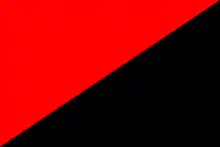Lucy Parsons
Lucy Eldine Gonzalez Parsons (born Lucia Carter;[2] 1851 – March 7, 1942)[1][3] was an American labor organizer, radical socialist and anarcho-communist. She is remembered as a powerful orator. Parsons entered the radical movement following her marriage to newspaper editor Albert Parsons and moved with him from Texas to Chicago, where she contributed to the newspaper he famously edited The Alarm.
Lucy Parsons | |
|---|---|
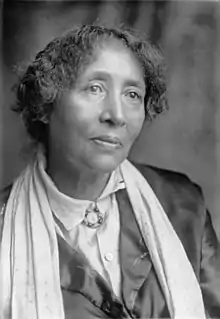 Parsons in 1920 | |
| Born | Lucia Carter 1851[1] |
| Died | March 7, 1942 (aged c. 91) Chicago, Illinois, US |
| Occupation | Labor organizer |
| Spouse(s) | Albert Parsons |
Following her husband's 1887 execution in conjunction with the Haymarket affair, Parsons remained a leading American radical activist, as a founder of the Industrial Workers of the World and member of other political organizations.
Biography
Early life
Lucy Parsons was born Lucia Carter in Virginia in 1851.[1] Her mother was an African-American slave owned by a white man named Tolliver, who may have been Lucy's father.[2] In 1863, during the Civil War, Tolliver relocated to Waco, Texas with his slaves.[4]
Little is known about her life following the move to Texas. She worked as a seamstress and a cook for white families.[2] Parsons lived with or was married to a former slave, Oliver Gathing, for a time prior to 1870.[5][6] During this relationship, she had an infant which died at birth.[2] In 1871, she married Albert Parsons, a former Confederate soldier. They were forced to flee north from Texas in 1873 due to intolerant reactions to their interracial marriage.[2] During the journey, Parsons altered her first name to Lucy. The couple settled in Chicago, Illinois.[2]
Organizing
Described by the Chicago Police Department as "more dangerous than a thousand rioters" in the 1920s, Parsons and her husband had become highly effective anarchist organizers primarily involved in the labor movement in the late 19th century, but also participating in revolutionary activism on behalf of political prisoners, people of color, the homeless and women. She began writing for The Socialist and The Alarm, the journal of the International Working People's Association (IWPA) that she and Parsons, among others, founded in 1883. Parsons worked closely with her friend and collaborator Lizzie Holmes in the early years of the 1880s, and the two of them led marches of working seamstresses in Chicago.[7] In 1886 her husband, who had been heavily involved in campaigning for the eight-hour day, was arrested, tried, and executed on November 11, 1887, by the state of Illinois on charges that he had conspired in the Haymarket Riot — an event which was widely regarded as a political frame-up and which marked the beginning of May Day labor rallies in protest.[8][9]
Parsons was invited to write for the French anarchist journal Les Temps Nouveaux[10] and spoke alongside William Morris and Peter Kropotkin during a visit to Great Britain in 1888.[10]
In 1892 she briefly published a periodical, Freedom: A Revolutionary Anarchist-Communist Monthly. She was often arrested for giving public speeches or distributing anarchist literature. While she continued championing the anarchist cause, she came into ideological conflict with some of her contemporaries, including Emma Goldman, over her focus on class politics over gender and sexual struggles.[11]
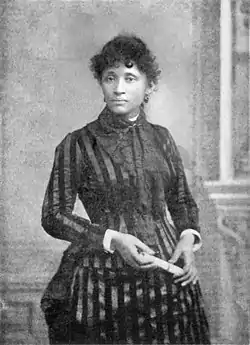
In 1905 she participated in the founding of the Industrial Workers of the World (IWW), and began editing the Liberator, an anarchist newspaper that supported the IWW in Chicago. Lucy's focus shifted somewhat to class struggles around poverty and unemployment, and she organized the Chicago Hunger Demonstrations in January 1915, which pushed the American Federation of Labor, the Socialist Party, and Jane Addams' Hull House to participate in a huge demonstration on February 12. Parsons was also quoted as saying: "My conception of the strike of the future is not to strike and go out and starve, but to strike and remain in, and take possession of the necessary property of production."[12] Parsons anticipated the sit-down strikes in the US and, later, workers' factory takeovers in Argentina.
In 1925 she began working with the National Committee of the International Labor Defense in 1927, a communist-led organization that defended labor activists and unjustly-accused African Americans such as the Scottsboro Nine and Angelo Herndon. While it is commonly accepted by nearly all biographical accounts (including those of the Lucy Parsons Center, the IWW, and Joe Knowles) that Parsons joined the Communist Party in 1939, there is some dispute, notably in Gale Ahrens' essay "Lucy Parsons: Mystery Revolutionist, More Dangerous Than A Thousand Rioters".[13] Ahrens points out that the obituary the Communist Party had published on her death made no claim that she had been a member.
Conflict with Emma Goldman
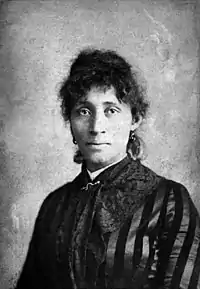
Emma Goldman and Lucy Parsons represented different generations of anarchism. This resulted in ideological and personal conflict. Carolyn Ashbaugh has explained their disagreements in depth:
Lucy Parsons' feminism, which analyzed women's oppression as a function of capitalism, was founded on working class values. Emma Goldman’s feminism took on an abstract character of freedom for women in all things, in all times, and in all places; her feminism became separate from its working class origins. Goldman represented the feminism being advocated in the anarchist movement of the 1890s [and after]. The intellectual anarchists questioned Lucy Parsons about her attitudes on the women's question.[14]
In 1908, after Captain Mahoney (of the New York City Police Department) crashed one of Goldman’s lectures in Chicago, newspaper headlines read that every popular anarchist had been present for the spectacle, "with the single exception of Lucy Parsons, with whom Emma Goldman is not on the best of terms."[15] Goldman reciprocated Parsons’s absence by endorsing Frank Harris' book The Bomb, which was a largely fictional account of the Haymarket Affair and its martyrs' road to death.[16] (Parsons had published The Famous Speeches of the Haymarket Martyrs, a non-fictional, first-hand recounting of the Haymarket martyrs' final speeches in court.)
Parsons was solely dedicated to working class liberation, condemning Goldman for "addressing large middle-class audiences"; Goldman accused Parsons of riding upon the cape of her husband’s martyrdom.[16] "[N]o doubt," Candace Falk wrote (Love, Anarchy, and Emma Goldman), "there was an undercurrent of competitiveness between the two women. Emma generally preferred center stage." Goldman planned on preserving her place in the spotlight as an American anarchist laureate by shoving risqué sexual and kinship discourse into "the center of a perennial debate among anarchists about the relative importance of such personal issues".
In The Firebrand, Parsons wrote, "Mr. [Oscar] Rotter [a free love advocate] attempts to dig up the hideous 'Variety' grub and bind it to the beautiful unfolding blossom of labor's emancipation from wage-slavery and call them one and the same. Variety in sex relations and economic freedom have nothing in common."[17] Goldman responded:
The success of the meeting was unfortunately weakened by Lucy Parsons who, instead of condemning the unjustified Comstock attacks and arrest of anarchists… took a stand against the editor of the Firebrand, [Henry] Addis, because he tolerated articles about free love… Apart from the fact that anarchism not only teaches freedom from the economic and political areas, but also in social and sexual life, L. Parsons has the least cause to object to treatises on free love… I spoke after Parsons and had a hard time changing the unpleasant mood that her remarks elicited, and I also succeeded in gaining the sympathy and the material support of the people present…[18]
Parsons responded: "The line will be drawn sharply at personalities as we know these enlighten no one and do infinitely more harm than good."[19]
Goldman, in her autobiography, Living My Life, briefly mentioned the presence of "Mrs. Lucy Parsons, widow of our martyred Albert Parsons", at a Chicago labor convention, noting that she "took an active part in the proceedings". Goldman later would acknowledge Albert Parsons for becoming a socialist and anarchist, proceeding to praise him for having "married a young mulatto"; there was no further mention of Lucy Parsons.[20]
Death
| Part of a series on |
| Socialism in the United States |
|---|
|
Parsons continued to give fiery speeches in Chicago's Bughouse Square into her 80s, where she inspired Studs Terkel.[21] One of her last major appearances was a speech to striking workers at International Harvester (the successor to the McCormick Harvesting Machine Company, whose striking workers played a role in the Haymarket Affair) in February 1941.[22]
Parsons died on March 7, 1942, in a house fire in the Avondale Community Area of Chicago.[23] Her lover, George Markstall,[24] died the next day from injuries he received while trying to save her. She was approximately 91 years old.[1] After her death, police seized her library of over 1,500 books and all of her personal papers. She is buried near her husband at Waldheim Cemetery (now Forest Home Cemetery), near the Haymarket Martyrs' Monument in Forest Park, Illinois.
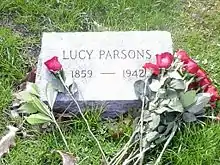
Origins and ethnicity
Parsons refused to speak about her private life or origins. When asked for details about her history, she declared "I am not a candidate for office, and the public have no right to my past. I amount to nothing to the world and people care nothing of me. I am battling for a principle."[2] This stance has made research into her origins difficult for historians.[2][25]
Parsons specifically denied that she was a child of a former slave of African descent, claiming that she was born in Texas and her parents were Mexican and Native American.[4] She described herself as a “Spanish-Indian maiden” to explain her dark complexion.[25] These personal myths persisted after her death: on her death certificate, her parents' names were listed as Pedro Díaz and Marites González, both born in Mexico.[26][27]
Legacy, tributes and memorials
The Lucy Parsons Center was founded in 1970 in Boston, Massachusetts. It continues as a collectively-run radical bookstore and infoshop.
In the 1990s, a local Chicago artist installed a memorial to Parsons in Wicker Park.[28]
In 2004, the city of Chicago named a park for Parsons.[21]
On July 16, 2007, a book that purportedly belonged to Lucy Parsons was featured on a segment of the PBS television series, History Detectives. During the segment it was determined that the book, which was a biography of Albert Parsons' co-defendant August Spies' life and trial, was most likely a copy published and sold by Parsons as a means of raising money to prevent her husband's execution. The segment also provided background on Parsons' life and the Haymarket Affair.
On October 15, 2015, a copy of William Morris's Signs of Change: Seven Lectures Delivered on Various Occasions was sold at auction in England. It was inscribed "To Lucy E Parsons from William Morris November 15, 1888", bore a "Property of Federal Bureau of Investigation US Department of Justice" stamp, and a "Surplus Library of Congress Duplicate" stamp; some of its pages showed traces of smoke damage.
In 2016, The Nation magazine released free and online a short film by animator Kelly Gallagher about Lucy Parsons, "More Dangerous Than a Thousand Rioters: The Revolutionary Life of Lucy Parsons."[29]
References
- Jones, Jacqueline (2017). Goddess of Anarchy: the Life and Times of Lucy Parsons, American Radical. New York: Basic Books. pp. i. ISBN 9780465078998. OCLC 982093458.
- Hunter, Tera W. (January 12, 2018). "Latina heroine or black radical? The complicated story of Lucy Parsons". The Washington Post. Retrieved November 13, 2019.
- "Lucy Parsons: Woman of Will | Industrial Workers of the World". www.iww.org. Retrieved May 1, 2018.
- Elinson, Elaine. ""Learn the Use of Explosives!": On Jacqueline Jones's "Goddess of Anarchy: The Life and Times of Lucy Parsons, American Radical"". Los Angeles Review of Books. Retrieved November 13, 2019.
- Smith, Jessie Carney (1992). Notable Black American Women. VNR AG. ISBN 9780810391772.
- Gay, Kathlyn (December 12, 2011). American Dissidents: An Encyclopedia of Activists, Subversives, and Prisoners of Conscience [2 volumes]: An Encyclopedia of Activists, Subversives, and Prisoners of Conscience. ABC-CLIO. ISBN 9781598847659.
- Carolyn, Ashbaugh (2011). Lucy Parsons: American Revolutionary. Chicago: Haymarket Books.
- Trachtenberg, Alexander (March 2002) [1932]. The History of May Day. Marxists.org. Retrieved January 19, 2008.
- Foner, Philip S. (1986). "The First May Day and the Haymarket Affair". May Day: A Short History of the International Workers' Holiday, 1886–1986. New York: International Publishers. pp. 27–39. ISBN 0-7178-0624-3.
- "Lucy Parsons: American Anarchist". Anarchist Writers. Retrieved August 14, 2013.
- "Lucy Parsons: Woman Of Will." Industrial Workers of the World.
- Wobblies! 14
- Lucy Parsons: Freedom, Equality and Solidarity: Writings and Speeches, 1878–1937
- Ashbaugh, Carolyn (1976). Lucy Parsons: American Revolutionary. Chicago: Charles H. Kerr Publishing. ISBN 0-88286-005-4.
- Daily Tribune (March 17, 1908); quoted in Falk, Love, Anarchy, and Emma Goldman, p. 65
- Falk, Candace (1984). Anarchy, Love, and Emma Goldman. p. 66. ISBN 0-03-043626-5.
- Parsons, Lucy. "On Variety", The Firebrand, September 27, 1896, Free Society; also in Ashbaugh, 204.
- Goldman, Emma. Emma Goldman: A Documentary…, pp. 312-313; originally featured in Part IV, Letters from A Tour, Sturmvogel, November 15, 1897.
- Parsons, Lucy. "Salutation to the Friends of Liberty", The Liberator Chicago, September 3, 1905; Lucy Parsons, Ahrens, ed., p. 88.
- Goldman, Emma (1931). Living My Life. Alfred A Knopf. ISBN 0-486-22544-5.
- Watkins, Nancy (November 9, 2008). "Who Loves Lucy?". Chicago Tribune Magazine. Tribune Co. p. 23. Retrieved September 7, 2013.
- "Haymarket Widows - By Carolyn Ashbaugh". March 7, 2012. Archived from the original on March 7, 2012. Retrieved June 18, 2020.
-
International News Service (March 8, 1942). "Widow Of Anarchist Dies When Chicago Home Burns". St. Petersburg Times (US). Retrieved September 3, 2017.
Mrs. Lucy Parsons 80-year-old blind anarchist whose first husband, Albert Parsons, died on the gallows as a result of the Haymarket riot, ...
-
"Haymarket Widows". The Lucy Parsons Project. Archived from the original on March 7, 2012. Retrieved February 22, 2018.
Lucy Parsons and her companion George Markstall, with whom she had lived since around 1910, died in a fire at their Chicago home in March 1942.
- Jacob, Mark. "Lucy Parsons bio reveals new facts about the birth, ethnicity of the 'Goddess of Anarchy'". chicagotribune.com. Retrieved November 13, 2019.
- Illinois, Deaths and Stillbirths Index, 1916-1947
- Henderson, Lori (2008). "Memory of Controversy and Controversial Memories: Lucy Parsons and the Haymarket Tragedy" (PDF). Historia. Eastern Illinois University. 17: 13–23. Retrieved March 8, 2016.
- Howard Besser, "Lucy Parsons Memorial", April 3, 1996.
- Gallagher, Kelly (November 15, 2016). "More Dangerous Than a Thousand Rioters: The Revolutionary Life of Lucy Parsons" – via www.thenation.com.
Works
- "A Word to Tramps," The Alarm, vol. 1, no. 1 (October 4, 1884), p. 1.
- "An Interview With Lucy Parsons on the Prospects for Anarchism in America," St. Louis Post-Dispatch, vol. 37, no. 95 (October 21, 1886), p. 4.
Further reading
- Carolyn Ashbaugh, Lucy Parsons: American Revolutionary. Chicago: Charles H. Kerr Publishing Co., 1976.
- Paul Avrich, The Haymarket Tragedy. Princeton, NJ: Princeton University Press, 1984.
- Gale Ahrens, Lucy Parsons: Freedom, Equality, & Solidarity, Writings and Speeches, 1878-1937. Charles H. Kerr Publishing. 2003.
- Paul Buhle and Nicole Schulman, Wobblies! A Graphic History of the Industrial Workers of the World. New York: Verso, 2005.
- Jacqueline Jones, Goddess of Anarchy: The Life and Times of Lucy Parsons, American Radical. New York: Basic Books, 2017.
- Dave Roediger and Franklin Rosemont (eds.), A Haymarket Scrapbook. Chicago: Charles H. Kerr Publishing Co., 1986.
- Keith Rosenthal, "Lucy Parsons: 'More Dangerous Than a Thousand Rioters'", Joan of Mark, September 6, 2011.
- "Lucy Parsons Is Burned to Death in Chicago; Husband Was Hanged After Haymarket Riot", the New York Times, March 8, 1942, p. 36.
External links
- The Lucy Parsons Center, a radical bookstore in Boston, Massachusetts
- Works by or about Lucy Parsons in libraries (WorldCat catalog)
- Lucy Parsons entry at the Anarchy Archives
- Carolyn Ashbaugh Research Papers at the Newberry Library

